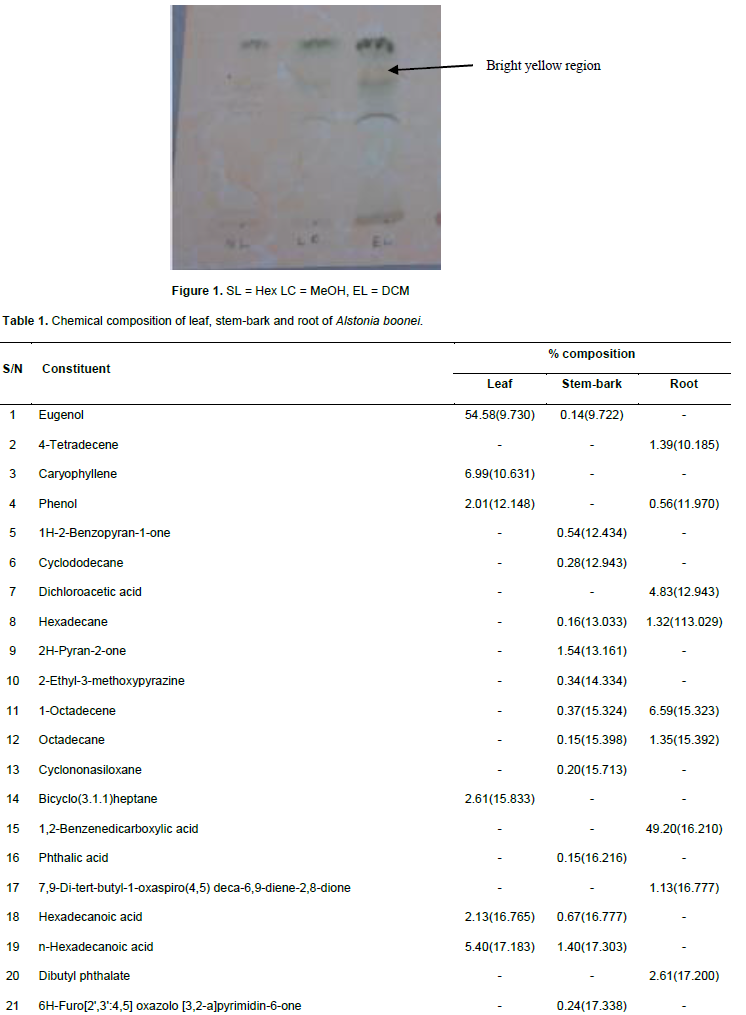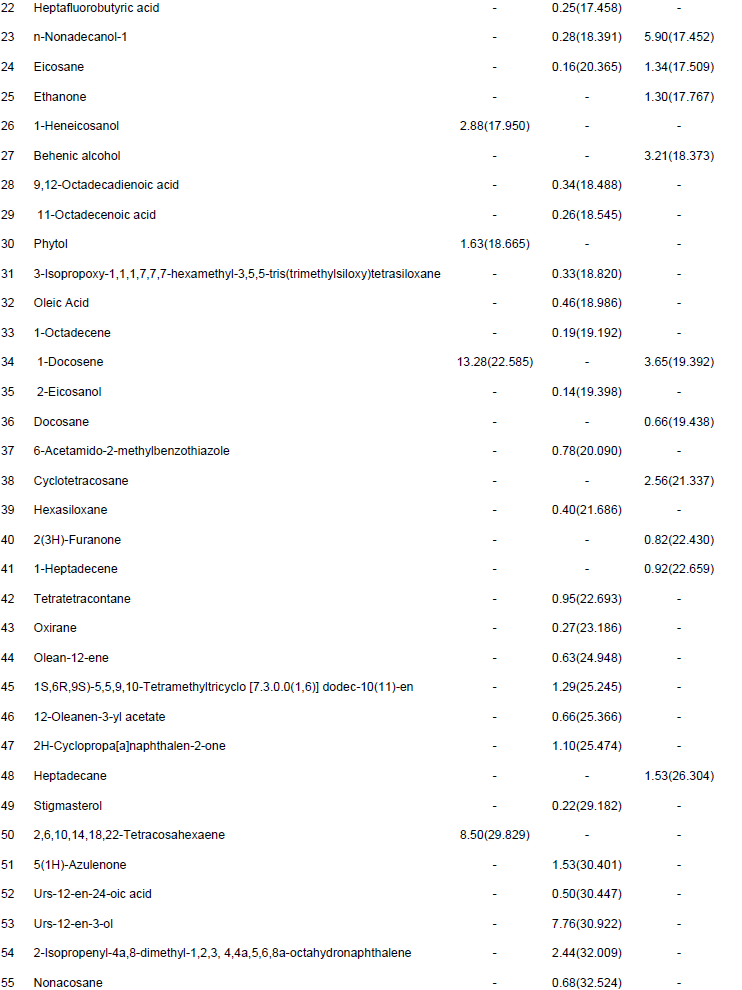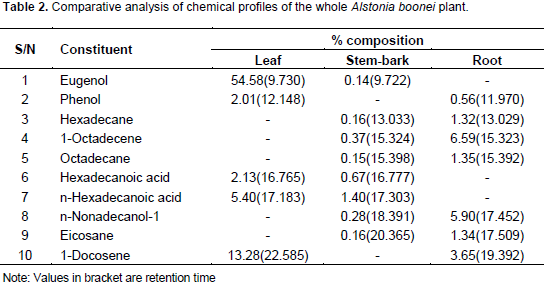ABSTRACT
Alstonia boonei De Wild is a medicinal plant commonly found in West African and is popularly known as God's tree. The plant parts have been traditionally used as a painkiller, antimicrobial, antimalarial and antidiabetic which have also been proved scientifically. Previous studies revealed little information on phytochemcial components of A. boonei. The present work aims at investigating and comparing the chemical components of the leaf, the stem-bark and the root of the plant in order to provide sufficient baseline information for isolation work on medicinal components of the plant. Leaf, stem-bark and root extracts of A. boonei were prepared by maceration using 1:1 EtOAc/MeOH. The crude extract was successively macerated with hexane, dichloromethane (DCM) and methanol. Thin layer chromatography (TLC) by 2,2-diphenyl-1-picrylhydrazyl (DPPH) (TLC-DPPH) analysis was used to screening out DCM fraction for further analysis. Gas chromatography and mass spectroscopy studies were performed to profile phytochemical constituent of the plant. The GC-MS analysis of DCM extract of the leaf revealed ten chemical components with Eugenol as major component (54.58%); DCM extract of the stem-bark showed forty one components with alpha-amyrin (32.25%) while DCM extract of the root revealed twenty components with 1,2-benzenedicarboxylic acid (49.2%) as major component. This study shows that the A. boonei extracts of the leaf, stem-bark and root consist of different types of compounds with few components common to two of the parts. Quantitatively, common phytochemicals decrease from leave to root. The most prominent compounds identified by GC/MS were Eugenol, benzenedicarboxylic acid and alpha-amyrin.
Key words: Phytochemicals, A. boonei, gas chromatography/mass spectroscopic studies, Eugenol
Alstonia boonei De Wild belongs to the family Apocynaceae. It is a herbal medicinal plant of West African origin, popularly known as God's tree, cheese wood and known locally among Yoruba in Nigeria as Ahun. All the parts of the plant are very useful but the thick bark cut from the matured tree is the part that is most commonly used for therapeutic purposes. Therapeutically, beta-amyrin and alpha-amyrin acetate isolated from the stem bark of A. boonei have been found to possess anti-inflammatory properties (Okoye et al.,2014) Antimicrobial activities of various fractions of stem bark of A. boonei were also tested against some microbes (Bello et al., 2009; Amole and Ilori, 2010; Misra et al., 2011). A wide array of chemical compounds have been isolated from A. boonei.
These include alkaloids, tannins, iridoids, and triterpenoids which have been demonstrated to possess some pharmacological activities (Akinmoladun et al., 2007). The alkaloids isolated from the plant include echitamine and other alkaloids, and the triterpenes b-amyrin, lupenol, and ursolic acid have all been isolated from leaves and stem bark (Adotey et al., 2012). Echitamine possess a battery of pharmacological and autonomic activities (Ojewole, 1983, 1984) including anticancer activities (Adotey et al., 2012; Ashok et al., 2015). Moronkola and Kunle (2012) reported essential oil compositions of the leaf, stem bark, and root of A. boonei. (Z)-9-Octadecenoic acid was found to be the most abundant volatile oil in the leaf and stem bark while methyl (7 E)- 7-octadecenoate was the most abundant in the root. The aim of this study was to investigate the distribution trend of A. boonei chemical composition
Sample preparation
A. boonei leaf, stem-bark and root were collected at a farmland in Akinmarin village, Oyo and were identified at the Department of Botany, University of Ibadan, Ibadan. The air-dried plant materials: (204.7 g) leaves, (282.5 g) stem-bark, and (102.9 g) root of, A. boonei, were exhaustively extracted separately with 1:1 EtOAc:MeOH for 3 days. The extracts were filtered separately, concentrated on rotary evaporator to about 50 ml and evaporated to dryness under vacuum. Each extract was successively macerated with hexane, dichloromethane and methanol. Obtained fractions were evaporated to dryness and stored in a refrigerator at +4°C until use.
Antioxidant screening
The method of Mensor et al. (2001) with Kotze and Eloff (2002) methods were adopted to screen fractions. Fractions obtained from leaves were developed on aluminium-backed thin layer chromatography (TLC) using solvent ratio: chloroform/ethyl acetate/formic acid (5:4:1) (intermediate polarity/acidic). Chromatogram was sprayed with 0.2%, 2,2, diphenyl-2-picryl-hydrazyl to detect antioxidant properties of various fractions.
Gas chromatography (GC)–mass spectrometer (MS) analysis
GC-MS: Hewlett-Packard 5890 gas chromatograph, combined with a Jeol JMS-HX 110 mass spectrometer with source at 270°C at 70 eV. Injector was set at 270°C with splitting ratio 1:30. The analysis was performed on the aforementioned programme on equivalent column HP-5 (25 m × 0.22 mm and 0.25 μm). A mass spectral survey was performed using the NIST mass spectral search program.
Qualitative analysis of antioxidant activity was used to screen out less potent fraction. The dichloromethane fraction displayed highest antioxidant activity after spraying chromatogram with DPPH because of the intensity of yellow colour produce. Dichloromethane (DCM) was then selected for phyto-constituent analysis. Thin layer chromatogram of hexane, dichloromethane and methanol fractions obtained from the leaves is shown in Figure 1. GC-MS analyses of DCM fraction of the leaf, the stem-bark and the root column of A. boonei are presented in Table 1. Constituents were listed in order of elution from HP-5 capillary column (Table 1). Gas chromatography-mass spectrometry analysis of the leaf extract resulted in the identification of 10 compounds, 41 compounds in stem-bark extract and 20 compounds in root extract.



Chemical compounds that were common to the three parts of the plant were presented in Table 2. A comparative analysis of chemical profiles of the leaf and stem-bark showed that hexadecanoic acid and n-hexadecanoic acid were present in the two parts but in higher proportion in the leaf while phenol and 1-Docosene were present in the leaf and the root. Hexadecane, 1-Octadecene, Octadecane, n-Nonadecanol-1 and Eicosane were present in both stem-bark and root. There is decrease in quantity of common phytochemicals from leave to root and root to stem. The results revealed that Eugenol (54.58), 1-Docosene (13.28), 2,6,10,14,18,22-Tetracosahexaene (8.50), Caryophyllene (6.99) and n-Hexadecanoic acid (5.40) were found as the five major components in the leaf extract, the minor compound was Phytol.

The major constituents of stem-bark extract were alpha-amyrin (32.25), 2(1H) Naphthalenone (10.32), 9,19-Cycloergost-24(28)-en-3-ol (9.13) and Urs-12-en-3-ol (7.76) while the major component found in root were 1,2-Benzenedicarboxylic acid (49.20), 1-Octadecene(6.59) And n-Nonadecanol-1(5.90).Jaganathan and Supriyanto (2012) reported that eugenol possess anticancer activity against various types of cancers. Bioactivity experiments revealed positive anti-cancer activity of 1, 2-Benzenedicarboxylic acid on PC3, MCF, HCT-116, A549, and MIAPACA cell lines (Save et al., 2015). Beta-Amyrin and alpha-amyrin acetate isolated from the stem bark of A. boonei display profound anti-inflammatory activity (Nkeoma et al., 2014).
The present study represents the comprehensive analysis of phyto-constituents of A. boonei leaf, stem-bark, and root DCM extracts. Percentage composition of common phytochemicals decreases from leaf to root. Previous study revealed that the three main components of A. boonei identified by GC-MS exhibit anticancer activity. Therefore, the results of this study will form the basis for selection of plant part for further investigation in the potential drug discovery.
The author has not declared any conflict of interest.
REFERENCES
|
Adotey JPK, Adukpo GE, Boahen YO, Armah FA (2012). A review of the ethnobotany and pharmacological importance of Alstonia boonei De Wild (Apocynaceae). Int. Scholar Res. Net 1:1-9.
Crossref
|
|
|
|
Akinmoladun AC, Ibukun EO, Afor E (2007). Chemical constituents and antioxidant activity of Alstonia boonei. Afri J Biotech 6(10):1197-201.
|
|
|
|
|
Amole OO and Ilori OO (2010). Antimicrobial Activity Of The Aqueous And Ethanolic Extracts Of The Stem Bark Of Alstonia boonei. Int. J. Phytopharmacol. 1(2):119-123.
|
|
|
|
|
Ashok R1, Lokesh SJ, Hari Kiran (2015) Studies on the anticataract activity of echitamine, an alkaloid from the stem bark of Alstonia scholaris. Der Pharmacia Lettre 7(5):197-199
|
|
|
|
|
Bello IS, Oduola T, Adeosun OG, Omisore NOA, Raheem GO, Ademosun AA (2009) Evaluation of Antimalarial Activity of Various Fractions of Morinda lucida Leaf Extract and Alstonia boonei Stem Bark. Glob. J. Pharmacol. 3(3):163-165.
|
|
|
|
|
Jaganathan SK, Supriyanto E (2012) Antiproliferative and molecular mechanism of eugenol-induced apoptosis in cancer cells. Molecules 17(6):6290-6304.
Crossref
|
|
|
|
|
Kotze M, Eloff JN (2002). Extraction of antibacterial compounds from Combretum microphyllum (Combretaceae). South Afr. J. Bot. 68(1):62-67.
Crossref
|
|
|
|
|
Mensor LL, Fabio SM, Gildor GL, Alexander SR, Tereza CD, Cintia SC, Suzane GL (2001). Screening of Brazilian plant extracts for antioxidant activity by the use of DPPH free radical methods. Phytother. Res. 15(2):127-130.
Crossref
|
|
|
|
|
Misra CS, Pratyush K, Sagadevan, LDM, James J, Veettil AKT, Thankamani V (2011). A comparative study on phytochemical screening and antibacterial activity of roots of Alstonia scholaris with the roots, leaves and stem bark. Int. J. Res. Phytochem. Pharmacol. 1(2):77-82.
|
|
|
|
|
Moronkola DO, Kunle OF (2012). Essential oil compositions of leaf, stem bark and root of Alsonia boonei de Wild (Apocyanaceae). Int J. Biol. Pharm. Res. 3(1):51-60.
|
|
|
|
|
Nkeoma NO, Daniel LA, Henry NO, Emmanuel EI, Chukwuemeka SN, Festus BCO (2014) beta-Amyrin and alpha-amyrin acetate isolated from the stem bark of Alstonia boonei display profound anti-inflammatory activity. Pharm. Biol. 52(11):1478-1486
Crossref
|
|
|
|
|
Ojewole JAO (1983). Autonomic pharmacology of echitamine, an alkaloid from Alstonia boonei De Wild. Fitoterapia 54(3):99-113.
|
|
|
|
|
Ojewole JAO (1984) Studies on the pharmacology of echitamine, an alkaloid from the stem bark of Alstonia boonei L. (Apocynaceae). Int. J. Crude Drug Res. 22(3):121-143.
Crossref
|
|
|
|
|
Save SA, Lokhande RS, Chowdhary AS (2015) Determination of 1, 2-Benzenedicarboxylic acid, bis (2-ethylhexyl) ester from the twigs of Thevetia peruviana as a Colwell Biomarker. J. Innov. Pharm. Biol. Sci. 2(3):349-362.
|
|